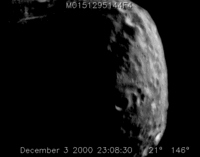14 years from the date of the first soft landing of the earth apparatus on an asteroid
14 years have passed since the day of the first soft landing of the earth apparatus on an asteroid. On February 14, 2001, the NEAR Shoemaker spacecraft landed on the near-Earth asteroid Eros . A year earlier, on February 14, 2000, the device entered the orbit of Eros, where he took the first pictures and collected data on the surface.

Eros is the first discovered near-Earth asteroid. He was discovered by the astronomer Karl Witt in 1898. In the distant future, as scientists believed in 1996, Eros might collide with the Earth. The first artificial satellite of the asteroid was the NEAR Spacecraft.

')
The case of the device had the form of a prism, the solar panels were installed on top. On the upper base of the prism is an antenna with a diameter of 1.5 meters. The total weight of the fuel - 805 kg, without fuel - 487 kg. For research, he used a multispectral camera, an IR spectrometer, a laser altimeter, a gamma-ray X-ray spectrometer, a magnetometer and a radio oscillator.

February 17, 1996 launched the spacecraft NEAR, he headed towards the asteroid Matilda. The journey took 16 months. In 1997, the vehicle flew 1200 kilometers from an asteroid, taking five hundred shots.

February 14, 2000 NEAR Shoemaker entered the orbit of Eros with a rotation period of 27.6 days, where he spent the following year. Then he took the first pictures of the asteroid and collected data on its surface and geology. Below - the first shot after entering orbit.


On February 14, 2001, news came out of a successful soft landing of a spacecraft on the surface of an asteroid. Landing took place at 15:01:52, completing the path of the apparatus of 3.2 billion kilometers. Vertical speed was less than four miles per hour.

The NEAR Shoemaker spacecraft was originally named Spacecraft, and was later named after the American geologist Eugene Shoemaker who died in a car crash in 1997. He founded a new direction in science - astrogeology. The remains of the scientist were buried on the moon, in the "Schumaker crater."


Eros is the first discovered near-Earth asteroid. He was discovered by the astronomer Karl Witt in 1898. In the distant future, as scientists believed in 1996, Eros might collide with the Earth. The first artificial satellite of the asteroid was the NEAR Spacecraft.

')
The case of the device had the form of a prism, the solar panels were installed on top. On the upper base of the prism is an antenna with a diameter of 1.5 meters. The total weight of the fuel - 805 kg, without fuel - 487 kg. For research, he used a multispectral camera, an IR spectrometer, a laser altimeter, a gamma-ray X-ray spectrometer, a magnetometer and a radio oscillator.

February 17, 1996 launched the spacecraft NEAR, he headed towards the asteroid Matilda. The journey took 16 months. In 1997, the vehicle flew 1200 kilometers from an asteroid, taking five hundred shots.

February 14, 2000 NEAR Shoemaker entered the orbit of Eros with a rotation period of 27.6 days, where he spent the following year. Then he took the first pictures of the asteroid and collected data on its surface and geology. Below - the first shot after entering orbit.


On February 14, 2001, news came out of a successful soft landing of a spacecraft on the surface of an asteroid. Landing took place at 15:01:52, completing the path of the apparatus of 3.2 billion kilometers. Vertical speed was less than four miles per hour.

The NEAR Shoemaker spacecraft was originally named Spacecraft, and was later named after the American geologist Eugene Shoemaker who died in a car crash in 1997. He founded a new direction in science - astrogeology. The remains of the scientist were buried on the moon, in the "Schumaker crater."

Source: https://habr.com/ru/post/374629/
All Articles